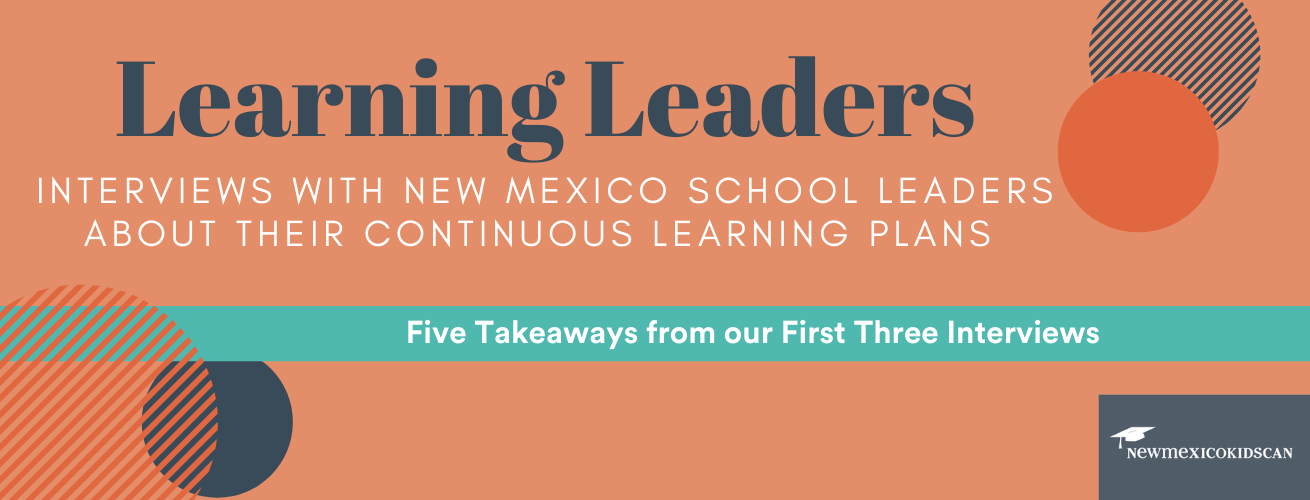Last month, we launched our new #LearningLeaders blog series in which interview New Mexico school districts and charter schools with strong continuous learning plans. Throughout the three interviews we have featured so far, we noticed some common themes among plans, some unique aspects, and some best practices we think other schools and districts should incorporate into their plans.
Here are 5 major takeaways from our first three interviews with Solare Collegiate Charter School, Cottonwood Classical Preparatory School and Cobre Consolidated Schools:
1. Plan Ahead
Some success of each district/school featured can be attributed to their preparedness, as all of the schools we interviewed had begun developing their continuous learning plans before the school closure was announced. Cobre, Cottonwood Classical, and Solare all contacted parents very early on and their teachers also took the time to develop lessons. By taking the time to develop a continuous learning plan sooner rather than later, the students and staff of these schools began distance learning faster than other schools across the state. This is a particularly important takeaway as we look toward an unpredictable future, that may include periods of distance learning through the next academic year.
2. Structure & Flexibility
Opposites? Possibly.
However, we recognize that the strongest plans incorporated both structure AND flexibility into their plan. Giving students clear guidelines and expectations to follow is crucial in order for their education to continue. With that being said, flexibility is critical during this time of upheaval for students and families. During this pandemic, schedules are different and can be difficult to anticipate so, if a student missed a live lesson, then having an option for them to go back and see what they missed is key for them to stay on track. In our interview with Rachael Sewards of Solare Collegiate Charter School, Sewards stated the use of both Google Classroom and Zoom have been some of the best aspects to their plan. Zoom allows teachers to host mandatory calls for students in order to keep that student and teacher interaction. The use of Google Classroom allows for high quality lessons that are always easily accessible for students.
3. Mitigate Accessibility Issues:
In our interview with John Binnert of Cottonwood Classical, Binnert mentioned how school closures have allowed accessibility to online learning to improve while simultaneously barring access from students without technology or internet access. Throughout our interviews, we noticed that limited access to technology is an issue for many schools and districts across the state. Access to learning devices and high speed internet is important when considering how to provide the best learning opportunities for students at home. One of our new policy goals for 2020 is to mandate the use of the stimulus funds to provide learning devices for all economically disadvantaged students. However, until then, districts such as Cobre were able to create a plan that catered to students of all needs. Their plan included 3 different options: fully online, hybrid, and paper packets.
4. Face-to-Face Time
Through the interviews, we saw that peer-to-peer and student-to-teacher interactions are important. Many of the schools wanted to provide opportunities for students to interact with each other, so incorporating time for students to see their classmates via Zoom or another platform is beneficial. The schools we interviewed also have many opportunities for students to interact with teachers, both online and offline. Binert stated that many parents have requested more optional video meetings so that students can interact with their friends. Even if a student doesn’t have access to technology and is learning with paper-packets, like some students in Cobre, they can still communicate with teachers via phone calls. The school leaders we interviewed stressed the importance of teachers reaching out to students that need more individual help. Giving students direct support can be challenging, but with school closures, it is more necessary than ever.
5. Feedback
Our final takeaway from the interviews is the importance of student and family feedback. Much of the success from these plans was due to the schools reaching out to families to see what they needed, such as more student-teacher interaction opportunities or changing the way assignments were given. Schools incorporating feedback will help students and families make the best out of the situation, and is the best way to keep students on track for the fall. We hope that schools continue to listen to family feedback, as another one of our 2020 Policy Goals is to ensure every parent has access to a parent conference prior to fall 2020. These conferences will allow schools and families to review student assessment results from the last completed academic year and interim assessments results from the 2019-2020 school year so that parents have the opportunity to make informed decisions about their student’s return to school in the fall.
If you haven’t read the full interviews yet make sure to check them out. We have more interviews to come with more schools and districts across the state. Make sure to follow our social media pages for updates on new blog posts!
Thank you again to Cobre Consolidated District, Cottonwood Classical Preparatory School, and Solare Collegiate Charter School for taking the time to talk with us, and thank you to our advocates for your continued support!

